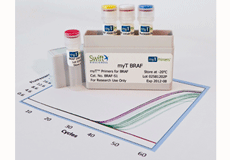New Primers Provide Significant Breakthrough in Assay Sensitivity

Complete the form below to unlock access to ALL audio articles.
myT BRAF-Ultra, an ultrasensitive version of myT BRAF, provides 0.01% sensitivity down to single copy detection of BRAF mutations and is now available from Swift. myT BRAF-Ultra can detect less than 10 copies of mutant BRAF V600E/K with very low breakthrough amplification from a background of 10,000  wild-type genomic DNA copies. While myT BRAF-Ultra works well with fresh frozen and FFPE samples, this level of sensitivity also makes the product ideal for use when the sample material is limiting or where the target is present at very low concentration, such as with circulating tumor cells (CTCs), serum, plasma and needle biopsies. Each myT BRAF-Ultra package includes sufficient reagents to assess up to 14 samples when run in triplicate, plus a positive and a negative control.
wild-type genomic DNA copies. While myT BRAF-Ultra works well with fresh frozen and FFPE samples, this level of sensitivity also makes the product ideal for use when the sample material is limiting or where the target is present at very low concentration, such as with circulating tumor cells (CTCs), serum, plasma and needle biopsies. Each myT BRAF-Ultra package includes sufficient reagents to assess up to 14 samples when run in triplicate, plus a positive and a negative control.
myT BRAF-Ultra is the newest addition to the myT Primer line of products. The first product in the family, myT BRAF, can detect 1% mutant BRAF V600E/K present in a background of 1,000 wild-type genomic DNA copies with no breakthrough amplification from wild-type, resulting in assays that give definitive Yes/No answers over a wide dynamic range and reduce or completely eliminate the need for delta Ct methods to call results. Each myT BRAF package includes sufficient reagents to assess up to 28 samples plus a positive and a negative control.
The extreme selectivity and reproducibility of myT Primers provides an increased level of confidence and convenience in qPCR assays and makes them ideal for use when the sample material is limiting or where the target is present at very low concentration. Additional myT Primer reagents will be coming soon, including primers for high sensitivity detection of KRAS mutations in codons 12 and 13.

